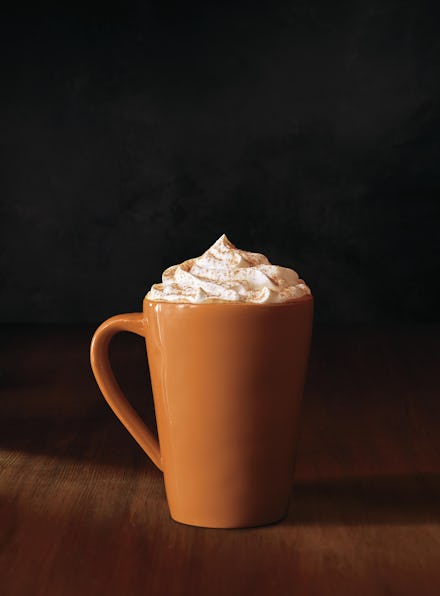What's in Starbucks' pumpkin spice latte? Pumpkin, but also some stuff you can't pronounce

It's still beach weather in many parts of the United States, but Starbucks gives zero f*cks. The coffee chain's sickly sweet harbinger of fall, the pumpkin spice latte, is officially back on menus nationwide, according to a press release.
So what exactly is in a PSL? Well in the press release, the coffee chain describes the drink as a "handcrafted" beverage made with "Starbucks signature espresso, perfectly steamed milk, and fall spices including cinnamon, ginger, nutmeg and clove."
The actual ingredient list (below) doesn't roll off the tongue as easily:
Milk, Pumpkin Spice Sauce [Sugar, Condensed Skim Milk, Pumpkin Puree, Contains 2% Or Less Of Fruit And Vegetable Juice For Color, Natural Flavors, Annatto, Salt, Potassium Sorbate], Brewed Espresso, Whipped Cream [Cream (Cream, Milk, Mono And Diglycerides, Carrageenan), Vanilla Syrup (Sugar, Water, Natural Flavors, Potassium Sorbate, Citric Acid)], Pumpkin Spice Topping [Cinnamon, Ginger, Nutmeg, Clove, Sulfiting Agents].
Still the drink, which looks (and smells) like a melted Yankee candle, isn't as Frankenstein-ien as one might expect. Besides having an absurdly high amount of sugar (a 16-ounce PSL made with 2% milk clocks in at 50 grams of sugar), the drink consists of relatively normal ingredients like cream, espresso, condensed skim milk and sugar.
The latte even contains "100% real, unsweetened pumpkin purée," per its press release. This was not always the case. The coffee chain only added the gourd to the drink in 2015, USA Today reported at the time. Starbucks also removed the caramel coloring from the drink.
There are a few concerning ingredients in the popular seasonal drink, however. First is the carrageenan found in the whipped cream. The thickening agent comes from seaweed, but that doesn't make it super healthy, Prevention noted. The ingredient is linked to "inflammation, gut irritation and ... cancer," according to the publication. Its presence isn't endemic to Starbucks' whipped cream product — consumers can also find it in Reddi Wip, one of America's most popular brands.
Potassium sorbate, which is found in the sauce and the syrup, is technically just a form of salt that acts as a preservative, Livestrong noted. The substance is found frequently on the menu of big chains: Dunkin' Donuts, McDonald's and Burger King all have multiple menu items that contain potassium sorbate. It's also used to prevent mold in foods like cheese, yogurt and pickles. But one study in 2010 found that the substance can potentially cause damage to DNA.
The sulfiting agents, which are used to prevent discoloration, are relatively harmless, notes the Texas A&M agriculture website. Some people, however, are sensitive to the agents and should be careful when downing pumpkin spice lattes.
Last but not least, the added whipped cream — what's a PSL without it? — contains mono- and diglycerides. These additives allow ingredients containing fats to bond with those containing water. Because they may contain trans fats, some have concerns about the adverse affects of the ingredients, but the Food and Drug Administration says they are harmless.
So if you are really concerned about the ingredient list of a pumpkin spice latte, but don't want to give up your steaming cup of sugary coffee-milk, consider nixing the creamy topping.
Still, the most concerning ingredient in the drink is the sugar. The U.S. government's dietary guidelines recommend adults consume no more than 48 grams of added sugar a day which is two grams less than a grande PSL. While the sugar content of the latte is high, that is pretty standard for any flavored drink.
A caramelized honey latte from Starbucks of the same size contains 45 grams of sugar and a Pumpkin Swirl Latte from Dunkin' Donuts has a whopping 53 grams of sugar. Given the harmful effects of high sugar consumption, carrageenan and sulfiting agents are the least of your problems.
• Sept. 1, 2016, 1:12 p.m.: This story has been updated.